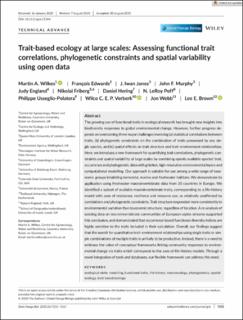| dc.description.abstract | The growing use of functional traits in ecological research has brought new insights into biodiversity responses to global environmental change. However, further progress depends on overcoming three major challenges involving (a) statistical correlations between traits, (b) phylogenetic constraints on the combination of traits possessed by any single species, and (c) spatial effects on trait structure and trait–environment relationships. Here, we introduce a new framework for quantifying trait correlations, phylogenetic constraints and spatial variability at large scales by combining openly available species’ trait, occurrence and phylogenetic data with gridded, high‐resolution environmental layers and computational modelling. Our approach is suitable for use among a wide range of taxonomic groups inhabiting terrestrial, marine and freshwater habitats. We demonstrate its application using freshwater macroinvertebrate data from 35 countries in Europe. We identified a subset of available macroinvertebrate traits, corresponding to a life‐history model with axes of resistance, resilience and resource use, as relatively unaffected by correlations and phylogenetic constraints. Trait structure responded more consistently to environmental variation than taxonomic structure, regardless of location. A re‐analysis of existing data on macroinvertebrate communities of European alpine streams supported this conclusion, and demonstrated that occurrence‐based functional diversity indices are highly sensitive to the traits included in their calculation. Overall, our findings suggest that the search for quantitative trait–environment relationships using single traits or simple combinations of multiple traits is unlikely to be productive. Instead, there is a need to embrace the value of conceptual frameworks linking community responses to environmental change via traits which correspond to the axes of life‐history models. Through a novel integration of tools and databases, our flexible framework can address this need. | en_US |

